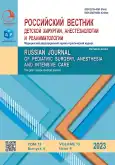通过显微外科自体移植足部组织复合物,分阶段修复儿童手部的4个手指
- 作者: Golyana S.I.1
-
隶属关系:
- Turner Scientific Research Institute for Children’s Orthopedics
- 期: 卷 13, 编号 4 (2023)
- 页面: 475-490
- 栏目: Original Study Articles
- URL: https://journals.rcsi.science/2219-4061/article/view/249858
- DOI: https://doi.org/10.17816/psaic1562
- ID: 249858
如何引用文章
详细
论证。目前足趾显微外科自体移植仍然是修复出生后或外伤后缺失手指的最有前途和最实用的方法。 在需要修复2个或更多足趾的情况下,同时移植双脚的组织复合物(包括1个或2个足趾)是可能的,也是必要的。因此,在一次手术过程中最多可以重建手部的4个手指。根据文献记载,这种手术很少进行,因为手术非常耗费人力和时间。
目的。本研究旨在展示在先天性和后天性病变的儿童中,通过显微外科手术将4个足足趾自体移植到手部的经验成果。
材料和方法。通过临床、X线、生物力学等方法,对9例先天性和后天性上肢畸形患者进行一次显微外科自体移植,每足2个组织复合体累及Ⅱ~Ⅲ指的治疗结果进行评价。确定了对手部缺失四指(或全部五指)的儿童实施这种显微外科重建方法的适应症;分析了结果、术后并发症以及对供体和受体区域的评估。
结果。在修复显微外科和手外科进行的914例儿童手部足趾自体移植手术中, 9例进行了4个足趾 (每个脚两个)的单阶段移植。患者的平均年龄为4.2岁。两名患儿的手部有先天性畸形,7名患儿的手部有外伤。8例手部II~V指修复,1例手部I~IV指修复。22%的移植物出现了与循环障碍相关的并发症,但这些并发症都是暂时的。所有移植的移植物都存活了下来。所有患者在手指移植后都需要继续接受手术治疗,以改善外观和功能。生物力学检查方法显示,他们在术后平均4个月(±1个月)就完全恢复了功能。
结论。这项研究表明,对于患有先天性和后天性手部病变的儿童,在需要恢复4个足趾时,使用这种手术的可能性和有效性都很高。一次显微外科足趾移植手术可恢复手部的良好外观和功能。
作者简介
Sergey I. Golyana
Turner Scientific Research Institute for Children’s Orthopedics
编辑信件的主要联系方式.
Email: ser.golyana@yandex.ru
ORCID iD: 0000-0003-1319-8979
SPIN 代码: 8360-8078
Dr. Sci. (Med.)
俄罗斯联邦, Saint Petersburg参考
- Shvedovchenko IV, Kol’tsov AA. Peresadka pal’tsev stopy na kist’ u detei s vrozhdennoi i priobretennoi patologiei — osnovnye problemy i puti ikh resheniya. Annaly plasticheskoi, rekonstruktivnoi i ehsteticheskoi khirurgii. 2017;(1):143. (In Russ.)
- Golyana SI, Avdeychik NV, Grankin DY, Safonov AV. Microsurgical toe-to-hand transfer in children. Modern Problems of Science and Education. Surgery. 2019;(6):150. (In Russ.) doi: 10.17513/spno.29371
- Jones NF, Clune JE. Thumb amputations in children: classification and reconstruction by microsurgical toe transfers. J Hand Surg Am. 2019;44(6):519.e1–519.e10. doi: 10.1016/j.jhsa.2018.08.013
- Avdeychik NV, Golyana SI, Grankin DY, et al. Possibilities of using microsurgical autotransplantation of tissue complexes in children. Pediatric Traumatology, Orthopaedics and Reconstructive Surgery. 2020;8(4):437–450. (In Russ.) doi: 10.17816/PTORS17896
- Nagrath N, Duggan E, Thurley N, Rodrigues JN. A Systematic review of the outcomes of microsurgical toe transfer for metacarpal and metacarpal-like hand deformity. J Hand Surg Asian Pac. 2022;27(1):32–42. doi: 10.1142/S2424835522500199
- Chi Z, Song DJ, Tian L, et al. Reconstruction of combined thumb amputation at the metacarpal base level and index amputation at the metacarpal level with pollicization and bilateral double toe composite transfer. J Plast Reconstr Aesthet Surg. 2017;70(8):1009–1016. doi: 10.1016/j.bjps.2017.05.032
- Tikhonenko TI, Golyana SI, Sokolova NE, et al. Evaluation criteria microcirculatory complications and anticoagulant therapy in microsurgical operations. Modern Problems of Science and Education. Surgery. 2020;(6):143. (In Russ.) doi: 10.17513/spno.30328
- Golyana SI, Tikhonenko TI, Govorov AV, et al. Complications after toe-to-hand transfers in children with pathologies of the hand. Pediatric Traumatology, Orthopaedics and Reconstructive Surgery. 2017;5(4):16–23. (In Russ.) doi: 10.17816/PTORS5416-23
- Minasov BSh, Garapov IZ, Biktasheva EM, et al. Results of the second toe autotransplantation for thumb reconstruction. Genij Ortopedii. 2022;28(1):34–38. (In Russ.) doi: 10.18019/1028-4427-2022-28-1-34-38
- Nikkhah D, Martin N, Pickford M. Paediatric toe-to-hand transfer: an assessment of outcomes from a single unit. J Hand Surg Eur. 2016;41(3):281–294. doi: 10.1177/1753193415594480.
- Belousov AE. Plasticheskaya rekonstruktivnaya i ehsteticheskaya khirurgiya. Saint Petersburg: Gippokrat, 1998. 744 p. (In Russ.)
- Buncke H Jr, Schulz WP. Experimental digital amputation and reimplantation. Plast Reconstr Surg. 1965;36(1):62–70. doi: 10.1097/00006534-196507000-00009
- O’Braien B. Mikrososudistaya vosstanovitel’naya khirurgiya. Transl. from eng. Moscow: Meditsina, 1981. 422 p. (In Russ.)
- Yoon AP, Jones NF. Long-term outcomes after toe-to-thumb transfers for burn reconstruction in children. J Burn Care Res. 2022;43(2):440–444. doi: 10.1093/jbcr/irab101.
- Wei FC, Al Deek NF. The battle ground between two giants: Toe transfer and hand allotransplantation. J Reconstr Microsurg. 2018;34(9):678–680. doi: 10.1055/s-0038-1639513
- Nakanishi A, Kawamura K, Omokawa S, et al. Quality of life in patients with toe-to-hand transplantation. J Plast Surg Hand Surg. 2018;52(6):359–362. doi: 10.1080/2000656X.2018.1520123
- Chen H, Jiang C, Xu Y, Sun Y. Toe-to-finger combined with free flap transfer for primary one-stage post-traumatic reconstruction of the complex fingerless hand. J Plast Reconstr Aesthet Surg. 2017;70(12):1708–1714. doi: 10.1016/j.bjps.2017.07.013
- Julve GG, Villén GM. The multiple monoblock toe-to-hand transfer in digital reconstruction. A report of ten cases. J Hand Surg. 2004;29(3):220–227. doi: 10.1016/j.jhsb.2003.11.003
- Jones NF, Graham D, Au K. Bilateral metacarpal hands: Reconstruction with 6 toe transfers. Hand (NY). 2020;15(4):465–471. doi: 10.1177/1558944718810844
- Al Deek NF, Lin Y-T, Wei F-C. Metacarpal-like and metacarpal hand. Hand Clin. 2016;32(4):549–554. doi: 10.1016/j.hcl.2016.06.004
- Wei FC, Al Deek NF, Lin YT, et al. Metacarpal-like hand: classification and treatment guidelines for microsurgical reconstruction with toe transplantation. Plast Reconstr Surg. 2018;141(1):128–135. doi: 10.1097/PRS.0000000000003940
- Ozols D, Zarins J, Petersons A. Novel technique for toe-to-hand transplantation: the fourth-toe as an alternative option for toe-to-hand transplantation for pediatric patients. Tech Hand Up Extrem Surg. 2019;23(2):74–80. doi: 10.1097/BTH.0000000000000234
补充文件




















